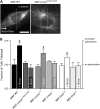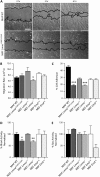Dysfunctional connections between the nucleus and the actin and microtubule networks in laminopathic models
- PMID: 18790843
- PMCID: PMC2586579
- DOI: 10.1529/biophysj.108.139428
Dysfunctional connections between the nucleus and the actin and microtubule networks in laminopathic models
Abstract
Laminopathies encompass a wide array of human diseases associated to scattered mutations along LMNA, a single gene encoding A-type lamins. How such genetic alterations translate to cellular defects and generate such diverse disease phenotypes remains enigmatic. Recent work has identified nuclear envelope proteins--emerin and the linker of the nucleoskeleton and cytoskeleton (LINC) complex--which connect the nuclear lamina to the cytoskeleton. Here we quantitatively examine the composition of the nuclear envelope, as well as the architecture and functions of the cytoskeleton in cells derived from two laminopathic mouse models, including Hutchinson-Gilford progeria syndrome (Lmna(L530P/L530P)) and Emery-Dreifuss muscular dystrophy (Lmna(-/-)). Cells derived from the overtly aphenotypical model of X-linked Emery-Dreifuss muscular dystrophy (Emd(-/y)) were also included. We find that the centrosome is detached from the nucleus, preventing centrosome polarization in cells under flow--defects that are mediated by the loss of emerin from the nuclear envelope. Moreover, while basal actin and focal adhesion structure are mildly affected, RhoA activation, cell-substratum adhesion, and cytoplasmic elasticity are greatly lowered, exclusively in laminopathic models in which the LINC complex is disrupted. These results indicate a new function for emerin in cell polarization and suggest that laminopathies are not directly associated with cells' inability to polarize, but rather with cytoplasmic softening and weakened adhesion mediated by the disruption of the LINC complex across the nuclear envelope.
Figures







Similar articles
-
Mammalian SUN protein interaction networks at the inner nuclear membrane and their role in laminopathy disease processes.J Biol Chem. 2010 Jan 29;285(5):3487-98. doi: 10.1074/jbc.M109.071910. Epub 2009 Nov 21. J Biol Chem. 2010. PMID: 19933576 Free PMC article.
-
LINC complex alterations in DMD and EDMD/CMT fibroblasts.Eur J Cell Biol. 2012 Aug;91(8):614-28. doi: 10.1016/j.ejcb.2012.03.003. Epub 2012 May 1. Eur J Cell Biol. 2012. PMID: 22555292 Free PMC article.
-
LINC complexes in health and disease.Nucleus. 2010 Jan-Feb;1(1):40-52. doi: 10.4161/nucl.1.1.10530. Nucleus. 2010. PMID: 21327104 Free PMC article. Review.
-
Accumulation of the inner nuclear envelope protein Sun1 is pathogenic in progeric and dystrophic laminopathies.Cell. 2012 Apr 27;149(3):565-77. doi: 10.1016/j.cell.2012.01.059. Cell. 2012. PMID: 22541428 Free PMC article.
-
Emery-Dreifuss muscular dystrophy: focal point nuclear envelope.Curr Opin Neurol. 2019 Oct;32(5):728-734. doi: 10.1097/WCO.0000000000000741. Curr Opin Neurol. 2019. PMID: 31460960 Free PMC article. Review.
Cited by
-
The nuclear envelope protein Nesprin-2 has roles in cell proliferation and differentiation during wound healing.Nucleus. 2012 Mar 1;3(2):172-86. doi: 10.4161/nucl.19090. Epub 2012 Mar 1. Nucleus. 2012. PMID: 22198684 Free PMC article.
-
Altered chromatin organization and SUN2 localization in mandibuloacral dysplasia are rescued by drug treatment.Histochem Cell Biol. 2012 Oct;138(4):643-51. doi: 10.1007/s00418-012-0977-5. Epub 2012 Jun 17. Histochem Cell Biol. 2012. PMID: 22706480 Free PMC article.
-
Ablation of SUN2-containing LINC complexes drives cardiac hypertrophy without interstitial fibrosis.Mol Biol Cell. 2019 Jul 1;30(14):1664-1675. doi: 10.1091/mbc.E18-07-0438. Epub 2019 May 15. Mol Biol Cell. 2019. PMID: 31091167 Free PMC article.
-
The perinuclear actin cap in health and disease.Nucleus. 2010 Jul-Aug;1(4):337-42. doi: 10.4161/nucl.1.4.12331. Epub 2010 Apr 23. Nucleus. 2010. PMID: 21327082 Free PMC article.
-
Lamin A/C Mechanotransduction in Laminopathies.Cells. 2020 May 24;9(5):1306. doi: 10.3390/cells9051306. Cells. 2020. PMID: 32456328 Free PMC article. Review.
References
-
- Capell, B. C., and F. S. Collins. 2006. Human laminopathies: nuclei gone genetically awry. Nat. Rev. Genet. 7:940–952. - PubMed
-
- Eriksson, M., W. T. Brown, L. B. Gordon, M. W. Glynn, J. Singer, L. Scott, M. R. Erdos, C. M. Robbins, T. Y. Moses, P. Berglund, A. Dutra, E. Pak, S. Durkin, A. B. Csoka, M. Boehnke, T. W. Glover, and F. S. Collins. 2003. Recurrent de novo point mutations in lamin A cause Hutchinson-Gilford progeria syndrome. Nature. 423:293–298. - PMC - PubMed
-
- Chen, L., L. Lee, B. A. Kudlow, H. G. Dos Santos, O. Sletvold, Y. Shafeghati, E. G. Botha, A. Garg, N. B. Hanson, G. M. Martin, I. S. Mian, B. K. Kennedy, and J. Oshima. 2003. LMNA mutations in atypical Werner's syndrome. Lancet. 362:440–445. - PubMed
-
- Manilal, S., T. M. Nguyen, C. A. Sewry, and G. E. Morris. 1996. The Emery-Dreifuss muscular dystrophy protein, emerin, is a nuclear membrane protein. Hum. Mol. Genet. 5:801–808. - PubMed
-
- Charniot, J. C., C. Pascal, C. Bouchier, P. Sebillon, J. Salama, L. Duboscq-Bidot, M. Peuchmaurd, M. Desnos, J. Y. Artigou, and M. Komajda. 2003. Functional consequences of an LMNA mutation associated with a new cardiac and non-cardiac phenotype. Hum. Mutat. 21:473–481. - PubMed
Publication types
MeSH terms
Substances
Grants and funding
LinkOut - more resources
Full Text Sources
Other Literature Sources
Miscellaneous

